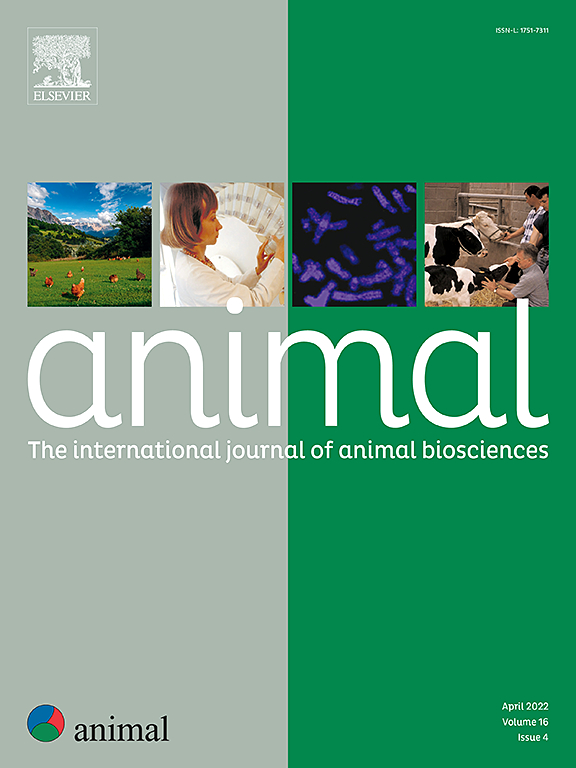3-硝基氧丙醇对荷斯坦奶牛和瑞士棕色奶牛肠道甲烷排放的影响及其与金合欢单宁提取物缺乏协同作用
IF 4.2
2区 农林科学
Q1 AGRICULTURE, DAIRY & ANIMAL SCIENCE
引用次数: 0
摘要
肠道甲烷(CH4)是农场温室气体排放的主要来源,由于其短期全球变暖潜力高,是一个关键的减缓目标。本研究旨在研究3-硝基氧丙醇(3-NOP)和金合欢单宁提取物(TAN)对奶牛产奶性能和甲烷排放的综合影响,以及它们与奶牛品种[褐瑞(BS) vs荷斯坦(HF)]的交互作用。选取16头多产中期泌乳奶牛,分别为8头BS奶牛和8头HF奶牛,采用分区设计,以品种为主要小区。每个小区内的奶牛被安排在一个重复的4 × 4拉丁方设计中,在4个24天的时间段(包括3-d采样)中采用2 × 2因子安排处理。试验饲粮为:(1)CON(基础总混合日粮)、(2)3- nop (60 mg/kg DM)、(3)TAN (3% DM)和(4)3- nop + TAN。尿液、粪便和气体排放的现场样本(通过GreenFeed)在每个周期结束时收集8次,超过3天。除CH4产量(g/kg DMI)和CO2产量外,未观察到3-NOP与TAN与品种在DM采食量(DMI)、产奶量或肠道气体排放方面的相互作用。品种影响DMI、产奶量和组分产量,与BS奶牛相比,HF奶牛DMI消耗多3.7 kg/d,产奶量多9.3 kg/d,饲料效率更高,组分产量更高。3-NOP对HF奶牛产奶量和能量修正乳(ECM)有提高的趋势,对BS奶牛的ECM有降低的趋势。饲用TAN的奶牛DMI降低1 kg/d,且3-NOP × TAN的降低趋势更明显,但产奶量、ECM和饲料效率保持不变。饲喂TAN的奶牛乳尿素氮(N)浓度降低18%,尿氮降低23.0%,粪氮排泄量占日氮摄入量的比例提高36.7%。在CH4产量(g/d)上观察到3-NOP与品种的交互作用,HF降低21.7%,BS降低13.0%。CH4产量和强度(g/kg ECM)也有3-NOP ×品种的趋势,HF奶牛的CH4产量和强度(g/kg ECM)分别降低了21.8%和23.4%,而BS奶牛的CH4产量和强度分别降低了11.0%和10.8%。综上所述,3-NOP和TAN在肠道CH4缓解方面不存在协同或相加效应。3-NOP对HF奶牛肠道CH4排放的缓解作用比BS奶牛更明显。需要进一步的研究来了解特定品种的反应并优化甲烷减缓战略,以便将其纳入国家温室气体清单。本文章由计算机程序翻译,如有差异,请以英文原文为准。
Divergent effects of 3-nitrooxypropanol on enteric methane emissions in Holstein and Brown Swiss cows, and its lack of synergy with acacia tannin extract
Enteric methane (CH4), the major contributor to on-farm greenhouse gas emissions, is a key mitigation target due to its high short-term global warming potential. The objectives of this study were to investigate the combined effects of 3-nitrooxypropanol (3-NOP) and Acacia mearnsii tannin extract (TAN), and their interactions with dairy cattle breed [Brown Swiss (BS) vs Holstein Friesian (HF)] on lactational performance and CH4 emissions. Sixteen multiparous mid-lactation cows, including 8 BS and 8 HF cows, were used in a split-plot design, with breed as the main plot. Cows within each subplot were arranged in a replicated 4 × 4 Latin Square design with a 2 × 2 factorial arrangement of treatments across four 24-d periods, including 3-d of sampling. The experimental diets were: (1) CON (basal total mixed ration), (2) 3-NOP (60 mg/kg DM), (3) TAN (3% of DM), and (4) 3-NOP + TAN. Spot samples of urine, faeces, and gas emissions (via GreenFeed) were collected at the end of each period 8 times over 3 days. No 3-NOP × TAN × Breed interactions were observed for DM intake (DMI), milk production, or enteric gas emissions, except for CH4 yield (g/kg DMI) and CO2 production. Breed influenced DMI, milk production, and component yields, with HF cows consuming 3.7 kg/d more DMI, producing 9.3 kg/d more milk, and achieving greater feed efficiency and higher milk component yields than BS cows. Milk yield and energy-corrected milk (ECM) tended to increase in HF but tended to decrease in BS cows by 3-NOP. Cows fed TAN had 1 kg/d lower DMI with the tendency for 3-NOP × TAN that showed greater reduction when TAN was fed alone, but milk yield, ECM, and feed efficiency remained unchanged. Cows fed TAN exhibited 18% lower milk urea nitrogen (N) concentration and 23.0% lower urinary N but 36.7% greater faecal N excretions as a percentage of daily N intake. A 3-NOP × Breed interaction was observed in CH4 production (g/d), with a 21.7% reduction in HF, and a 13.0% reduction in BS. Similarly, there were 3-NOP × Breed tendencies in CH4 yield and intensity (g/kg ECM), with reductions in HF cows of 21.8 and 23.4%, respectively, compared to 11.0 and 10.8% in BS cows. In conclusion, there were no synergistic or additive effects between 3-NOP and TAN on enteric CH4 mitigation. The enteric CH4 emission mitigating effect of 3-NOP was more pronounced in HF cows than in BS cows. Further research is needed to understand breed-specific responses and to optimise CH4 mitigation strategies for inclusion in national greenhouse gas inventories.
求助全文
通过发布文献求助,成功后即可免费获取论文全文。
去求助
来源期刊

Animal
农林科学-奶制品与动物科学
CiteScore
7.50
自引率
2.80%
发文量
246
审稿时长
3 months
期刊介绍:
Editorial board
animal attracts the best research in animal biology and animal systems from across the spectrum of the agricultural, biomedical, and environmental sciences. It is the central element in an exciting collaboration between the British Society of Animal Science (BSAS), Institut National de la Recherche Agronomique (INRA) and the European Federation of Animal Science (EAAP) and represents a merging of three scientific journals: Animal Science; Animal Research; Reproduction, Nutrition, Development. animal publishes original cutting-edge research, ''hot'' topics and horizon-scanning reviews on animal-related aspects of the life sciences at the molecular, cellular, organ, whole animal and production system levels. The main subject areas include: breeding and genetics; nutrition; physiology and functional biology of systems; behaviour, health and welfare; farming systems, environmental impact and climate change; product quality, human health and well-being. Animal models and papers dealing with the integration of research between these topics and their impact on the environment and people are particularly welcome.
 求助内容:
求助内容: 应助结果提醒方式:
应助结果提醒方式:


